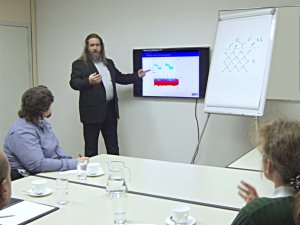


In 2025, Eureca will continue to organize regular seminars on optoelectronic components—essential components for a wide range of modern applications. Our events are aimed at developers and users, whom we introduce to the properties and limitations of these highly developed components. In addition, purchasers and sales staff learn how to correctly apply important technical terms and working methods in their daily work with these components.

In the basic seminar, the structure, function and resulting properties of CCD and CMOS sensors are explained in detail. In addition to the differences in the architectures and the physical limits, various measurement methods for characterizing image sensors are also covered.
Building on the basic seminar, our advanced seminars delve deeper into more advanced topics relating to the use of CCD/CMOS image sensors. After a brief review of the basics, the focus is on the following key topics—always rounded off by an open discussion round in which your questions are answered.
How is a precise image created from light? The seminar deals with pixels, sensitivity and noise, shows the influence of AI on image quality and clarifies the difference between »beautiful« and »correct«. Simulations and live demos are used to analyze optimal image quality in a practical way.
Resolution, contrast and parameter space determine the image quality. FOV, WD and SD set limits for object size and details. Factors such as albedo, surface and movement require precise adjustments to lighting and camera. SNR, focal length and aperture optimize measurement accuracy for the best results.
Objectives
Parameter space
Conversion into electro-optical parameters
Further topics
Photon transfer
From sensor analysis to optical resolution—focus on key image processing parameters. The photon transfer method provides essential measured values such as conversion gain, full well and read noise. The Siemens star helps to assess resolution and contrast. The quantum efficiency shows how efficiently a sensor processes light. Practical examples and a live demo with the e9u-LSDM-TCD1304 make the concepts tangible.
New to the program is a one-day seminar dedicated specifically to image capture techniques. This seminar is aimed not only at our customers from research and industry, but also at ambitious professional and prosumer photographers.
Our seminars offer you in-depth specialist knowledge, practical examples and interactive discussions—everything to prepare you optimally for the use of state-of-the-art optoelectronic components. We look forward to welcoming you to our events!
The exact dates and venues will be announced here shortly. Please contact us if you are interested or follow us on LinkedIn, to stay up to date.
Here you can easily ask a question or inquiry about our products:
Last update: 2025-28-02
